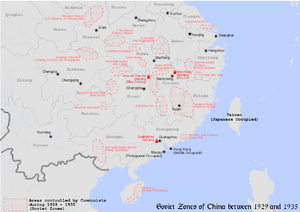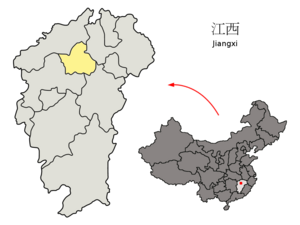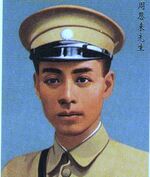انتفاضة نانتشانگ
| انتفاضة نانتشانگ | |||||||
|---|---|---|---|---|---|---|---|
| جزء من الحرب الأهلية الصينية | |||||||
 موقع انتفاضة نانتشانگ. | |||||||
| |||||||
| المتحاربون | |||||||
|
|
| ||||||
| القادة والزعماء | |||||||
|
|
| ||||||
| انتفاضة نانتشانگ Nanchang Uprising | |||||||||||||
|---|---|---|---|---|---|---|---|---|---|---|---|---|---|
| الصينية التقليدية | 南昌起義 | ||||||||||||
| الحروف المبسطة | 南昌起义 | ||||||||||||
| |||||||||||||
| الاسم الصيني البديل | |||||||||||||
| الصينية التقليدية | 八一起義 | ||||||||||||
| الحروف المبسطة | 八一起义 | ||||||||||||
| المعنى الحرفي | الانتفاضة الأولى بأغسطس | ||||||||||||
| |||||||||||||
انتفاضة نانتشانگ (الصينية: 南昌起义; پنين: Nánchāng Qǐyì ؛ Nanchang Uprising) كانت أول اشتباك رئيسي بين الحزب الوطني الصيني والحزب الشيوعي الصيني في الحرب الأهلية الصينية، بدأها الشيوعيون الصينيون رداً على مذبحة شانغهاي في 1927 التي قام بها الكومنتانگ.
أسس الكومنتانگ (KMT) الجناح الأيسر "لجنة ثورية" في نانتشانگ to plant the spark that was expected to ignite a widespread peasant uprising. Deng Yanda, Song Qingling and Zhang Fakui (listed nominally, who later crushed the uprising) were among the political leaders.[1]
Military forces in نانتشانگ under the leadership of He Long and ژو إنلاي rebelled in an attempt to seize control of the city after the end of the first Kuomintang-Communist alliance. Other important leaders in this event were Zhu De, Ye Ting، و Liu Bocheng.
Communist forces successfully occupied نانتشانگ and escaped from the siege of Kuomintang forces by 5 August, withdrawing to the Jinggang Mountains في غرب جيانگشي. 1 August was later regarded as the anniversary of the founding of the People's Liberation Army (PLA) and the first action fought against the Kuomintang and the الجيش الثوري الوطني (NRA).
الأسماء
In Chinese, apart from the name shown above, the event is known as انتفاضة نانتشانگ في 1 أغسطس (الصينية المبسطة: 八一南昌起义; الصينية التقليدية: 八一南昌起義; پنين: Bāyī nánchāng qǐyì), 1 August Uprising (الصينية المبسطة: 八一起义; الصينية التقليدية: 八一起義; پنين: Bāyī qǐyì), Nanchang Rebellion (الصينية: 南昌起事; پنين: Nánchāng qǐshì), Nanchang Insurrection (الصينية المبسطة: 南昌暴动; الصينية التقليدية: 南昌暴動; پنين: Nánchāng Bàodòng), or Nanchang Mutiny (الصينية المبسطة: 南昌兵变; الصينية التقليدية: 南昌兵變; پنين: Nánchāng Bīngbiàn).
The Government of the People's Republic of China and the Chinese Communist Party refer this as the Nanchang Uprising, while the Government of the Republic of China and the Chinese Nationalist Party refer this as the Nanchang Rebellion or the August 1 Violence.
نسق المعركة
القوات الشيوعية
بلغ عدد القوات الشيوعية في أوج انتفاضة نانتشانگ ما يزيد عن 20,000، بالرغم من أن بعضهم لم يشارك في القتال حتى اليوم التالي. The entire Communist force was organized into the 2nd Front Army, and over half of it was under He Long's command. He was also named Commander-in-Chief of the 2nd Front Army, and Ye Ting as deputy Commander-in-Chief and acting front-line Commander-in-Chief. Communist representative was ژو إنلاي, chief of staff was Liu Bocheng and Director of the Political Directorate of the 2nd Front Army was گوو موروو. فيما يلي نسق القتال للقوات الشيوعية:
- 9th Army commanded by Zhou Enlai, with Zhu De as the deputy commander and Zhu Kejing (朱克靖) as the Communist Party representative.
- 11th Army commanded by Ye Ting, with Cai Tingkai as the deputy commander and Nie Rongzhen as the party representative.
- 10th Division commanded by Cai Tingkai (蔡廷锴)
- 24th Division commanded by Gu Xunming/Dong Zhongming (古勋铭/董仲明)
- 25th Division commanded by Li Hanhun (李汉魂), and after taking Nanchang by Zhou Shidi (周士第)
- 20th Army commanded by He Long and Liao Qianwu (廖乾吾) as the communist representative
- 1st Division commanded by He Jinzhai (贺锦斋)
- 2nd Division commanded by Qing Guangyuan (秦光远)
- 3rd Division commanded by Zhou Yiqun (周逸群)
معركة نانتشانگ
The rebellion was initially planned to take place during the night of July 30, but due to complications with Zhang Guotao[بحاجة لمصدر] it was postponed until the next day. On the morning of 1 August 1927, at exactly 2:00 a.m., Zhou Enlai, He Long, Nie Rongzhen, Ye Ting, Ye Jianying, Lin Biao, Zhu De, Chen Yi and Liu Bocheng led their troops and attacked the city of Nanchang from different directions. Four hours later they took the city, capturing 5,000 small arms and around 1,000,000 rounds of ammunition.
Around noon the Revolutionary Committee of the Chinese Nationalist Party (中國國民黨革命委員會) was established (not to be confused with the Revolutionary Committee of the Kuomintang which was founded in 1948) to quell the insurgency. The committee has 25 members:[2] Deng Yanda (邓演达), Zhang Fakui (张发奎), Tan Pingshan (谭平山), Chen Youren (陈友仁), Wu YuZhang (吴玉章), Peng Zemin (彭泽民), Lin Zuhan (林祖涵), He Long (贺龙), Guo Moruo (郭沫若), Huang Qixiang (黄琪翔), Yun Daiying (恽代英), Jiang Hao (江浩), Zhu Huiri (朱晖日), Zhou Enlai (周恩来), Zhang Guotao (张国焘), Ye Ting (叶挺), Zhang Shushi (张曙时), Li Lisan (李立三), Xu Teli (徐特立), Peng Pai (彭湃), Su Zhaozheng (苏兆征), Song Qingling (宋庆龄), He Xianning (何香凝), Yu Youren (于右任) and Jing Hengyi (经亨颐).
التراجع
Facing a counterattack from the Nationalists, the Communists decided to retreat south towards مقاطعة گوانگدونگ. Once there they would try to take over مدينة گوانگژو while spreading their influence to the peasants and farms in that area.

التنبؤ بالكارثة
Guangzhou was the target set by the Soviet Comintern and, on August 3, Communist troops pulled out of Nanchang. Their Little Long March came to an end at the beginning of October, as they came down out of the Hakka uplands and into the Chaoshan area. In Chaozhou they were defeated by Nationalist-affiliated troops. Communist forces were broken up and traveled in two general directions, one heading to Shanwei where they engaged the Nationalists in guerrilla warfare under Peng Pai, and the other to southern Hunan, where they eventually joined a force under Mao Zedong, whose abortive Autumn Harvest Uprising had been no more successful.
The Communist forces had suffered such a decisive and disastrous defeat that only 1,000 soldiers remained as a complete unit, reforming into a regiment. Under the command of Zhu De and Chen Yi, who had faked their names, the regiment went to a local Hunan warlord and sought refuge. From this humble beginning the force eventually grew to 10,000 strong, traveling to Jiangxi and joining Mao Zedong at Jinggangshan in April 1928.
Liu Bocheng became a fugitive but was lucky enough to find other Communists who helped him and eventually sent him to the Soviet Union for military training, while Lin Biao deserted after the defeat. However, he had to return to the Communist force because of his fear that locals hostile to his side would turn him over to his enemies or kill him. Guo Moruo fled to Japan after the defeat.
Other surviving members were much less fortunate; all became fugitives. Zhou Enlai, Ye Jianying and Ye Ting lost contact with the others and fled to British Hong Kong, with Zhou seriously ill. The three had two pistols with them and were successful in reaching Hong Kong. Nie Rongzhen, the other communist leader, also successfully escaped to Hong Kong.
خى لونگ
خى لونگ had strongly opposed the retreat plan, accurately pointing out that marching 1000 miles in the heat of summer would put a severe strain on the troops, and that popular support for the Communists in Guangdong was merely a fraction of the huge support they had among the peasantry in Hunan. His opinion was that the new Communist base should be established in the border region of Hunan, suggesting that in Hunan the Communist troops would be easily resupplied and their numbers increased by the enlistment of the local populace. However, his suggestion was vetoed.
خى لونگ went home alone after the defeat. Demoted from his position as an army commander in charge of tens of thousands of men to that of a beggar, he was not well received by his family except for a few who were already Communists. He would soon raise another force of Communist soldiers, this time more than 3000 strong, but it would be wiped out by the Nationalists, with less than three dozen members surviving. It would take a year for He Long's force to recover for the third time.
انظر أيضاً
المراجع
الهامش
- ^ Schwartz, Benjamin, Chinese Communism and the Rise of Mao, Harper & Row (New York: 1951), p. 93.
- ^ "南昌起义时公布的各种人员名单 南昌八一起义纪念馆 CCTV.com". Archived from the original on 2012-05-21. Retrieved 2015-05-04.
المصادر
- Jung Chang and Jon Halliday, Mao: The Unknown Story (London, 2005); Jonathan Cape, ISBN 0-679-42271-4.
- Nanchang Mutiny http://www.republicanchina.org/NanchangMutiny-v0.pdf
وصلات خارجية
- https://web.archive.org/web/20040611014112/http://81.china1840-1949.net.cn/qyjj.htm
- https://web.archive.org/web/20030810044407/http://news.xinhuanet.com/ziliao/2003-07/28/content_996380.htm
- Short description is different from Wikidata
- Articles with hatnote templates targeting a nonexistent page
- Articles containing صينية-language text
- Articles containing simplified Chinese-language text
- Articles containing traditional Chinese-language text
- Articles containing Chinese-language text
- مقالات ذات عبارات بحاجة لمصادر
- نزاعات 1927
- احتجاجات 1927
- أحداث أغسطس 1927
- العمليات العسكرية في الحرب الأهلية الصينية
- 1927 في الصين
- الجيش الثوري الوطني
- التاريخ العسكري لجيانگشي
